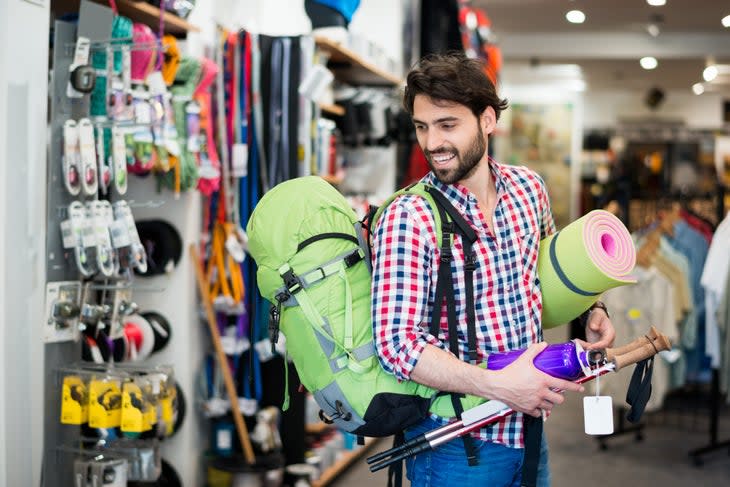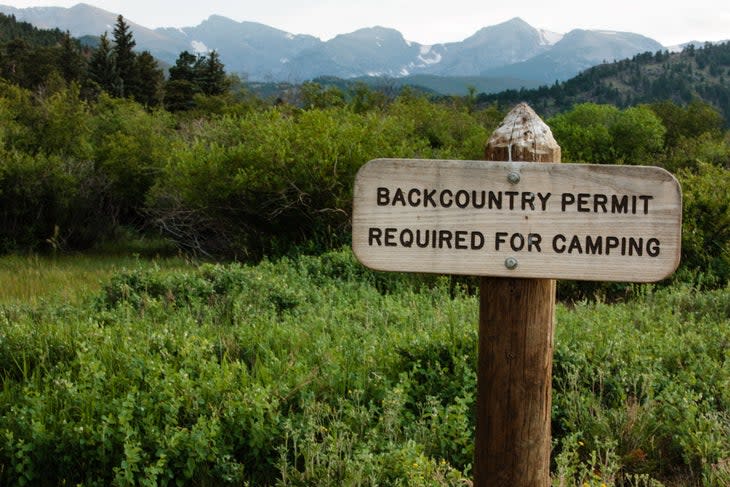How to Save $1,000 on Your Next Backpacking Trip
This article originally appeared on Backpacker
Many of us had to tighten our pursestrings in 2022, and it might feel like a big trip isn't feasible for the new year. Backpackers love to embrace the dirtbag aesthetic, but the truth is, gear costs and transportation can add up, especially if you want to hike at a lifelist destination far from home. But with some careful planning, it's possible to embark on a spectacular hike while keeping your hard-earned dollars in the bank. We did the budgeting for you, so you can focus on hitting the trail.
The following budget is based on estimated costs for an average weeklong backpacking trip in the US. We assumed the budgeter will have most of the gear they need, but may need to upgrade a few key items.
Gear

For first-time backpackers, it's the biggest barrier to entry, but gear costs shouldn't keep you from hitting the trail. If your hike requires equipment you don't already own, don't head straight to REI. Borrowing from friends and family (or even strangers in your local hiking club or community Facebook page) lets you gear up for free, and your retirement fund will thank you. If that's not an option, look to rent from your local outfitter, a college outdoors club (some rent to the public), or purchase secondhand. You can also stretch the use of the gear you already own with some modifications, like using two sleeping bags instead of purchasing one with a lower temperature rating, using a bag liner, or adding sock liners to non-waterproof boots.
Standard Cost:
New on-sale 0degF sleeping bag: $400
New microspikes: $75
New baselayers: $80
TOTAL: $555
Budget Cost:
Rented 0degF sleeping bag: $52
Rented microspikes: $28
Borrowed baselayers: $0
TOTAL: $80
Total Savings: $475
Food
If you already have the gear you need, food can be one of the biggest expenses for a backpacking trip, especially if you prioritize nutrition and taste. Backpacker's top pick for freeze-dried dinner costs around $16 per pouch, and even more budget-friendly brands will cost you at least $10 per pouch. They're dang tasty, but for a weeklong trek, that's over 100 big ones for dinner alone (and don't even get us started on snacks).
Thru-hikers and dirtbags the world over have refined the art of fueling up on pennies, and we can learn a thing or two from them--with caveats. Twinkies and ramen packets are cheap, but over the long term they're bad for you, and won't leave you as satisfied as a well-rounded meal. Fortunately, with a little extra work, you can have it all: taste, nutrition, and cost savings.
Dehydrating meals at home is the best way to ensure you're packing what you like to eat without carrying heavy fresh ingredients. And while there's an upfront cost for a kitchen dehydrator, it'll pay for itself in just a few trips. Or, avoid the sticker shock by dehydrating right in your oven. You can even dehydrate your leftovers to save on that pre-hike grocery run.
Standard food cost:
7 freeze-dried dinners: $85
7 freeze-dried breakfasts and oatmeal: $35
Snacks and lunch food: $35
TOTAL: $155
Budget food cost:
7 home-dehydrated dinners: $35
7 servings of instant oatmeal, dried fruit, and granola: $12
Snacks and lunch food: $35
TOTAL: $82
Total savings: $73
Fees and Permits

Many big-name destinations like national parks require hikers and campers to pay overnight camping permits, or even fees just to access the trail. These permits are important for conserving beautiful areas by limiting foot traffic and camping use, funding preservation, and preserving a quiet, immersive experience for visitors. While those fees are typically nominal compared to backpacking's other costs, they still offer an opportunity to save. Instead of visiting a national park or popular destination, plan your hike for somewhere off the beaten path. Some state and national forests don't require overnight permits, and it's free to dispersed camp on Bureau of Land Management land. As a bonus, you'll likely find more solitude on less-visited trails.
Standard cost:
National park entry fee: $30
Permits and camping: $100
TOTAL: $130
Budget cost:
Parking and entry: $0
Permits and camping $0
TOTAL: $0
Total savings: $130
Location
Of course, travel is the most significant cost with big backpacking trips. If you're really looking to keep a strict budget this year, commit to exploring close to home. There's plenty to love about staying local--not just the extra cash in your pocket. But if you're really itching to get further afield, a classic road trip can deliver you to dreamy mountainscapes without the cost of flying. When you can, carpool with your hiking buddies and split the gas.
Standard cost:
Flights: $200
Rental car: $250
TOTAL: $450
Budget cost:
Gas (600 miles): $70
TOTAL: $70
Total savings: $380
Total Trip Savings: $1,058
At that rate, you'll have enough savings to plan your dream hike for 2024.
For exclusive access to all of our fitness, gear, adventure, and travel stories, plus discounts on trips, events, and gear, sign up for Outside+ today.

